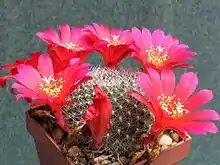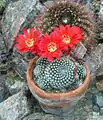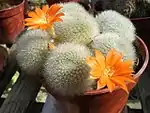Rebutia
Rebutia is a genus in the family Cactaceae, native to Bolivia and Argentina. They are generally small, colorful cacti, globular in form, which freely produce flowers that are relatively large in relation to the body. They have no distinctive ribs, but do have regularly arranged small tubercles. They are considered fairly easy to grow and they may produce large quantities of seeds that germinate freely around the parent plant.
| Rebutia | |
|---|---|
 | |
| Rebutia minuscula var. wessneriana | |
| Scientific classification | |
| Kingdom: | |
| (unranked): | |
| (unranked): | |
| (unranked): | |
| Order: | |
| Family: | |
| Subfamily: | |
| Tribe: | |
| Genus: | Rebutia |
The limits of the genus are currently uncertain – in particular whether or not it includes species formerly or currently placed in the genera Aylostera, Cintia, Sulcorebutia and Weingartia. The number of species included varies widely from source to source. A very large number of plants that have been treated in cultivation as species of Rebutia are now generally regarded as varieties, forms or synonyms of a much smaller number of species.
Systematics
The genus was designated in 1895 by Karl Moritz Schumann[1] and named after Pierre Rebut (1828–1902), a French cactus nurseryman. The type species is R. minuscula, which has been in cultivation since 1887.[2][3]
Limits of the genus
There has been considerable debate about the extent of the genus. In the middle of the twentieth century there was a tendency to separate groups of plants within Rebutia as new genera, e.g. Mediolobivia, whereas towards the end of the century the reverse tendency predominated, with genera previously regarded as separate, such as Weingartia, being subsumed within Rebutia. At the beginning of the twenty-first century there was a broad consensus, as reflected in Kew's list of Vascular Plant Families and Genera, that the following genera should be regarded as synonyms of Rebutia:[4]
- Aylostera Speg.
- Bridgesia Backeb.
- Cylindrorebutia Fric & Kreuz.
- Digitorebutia Fric & Kreuz.
- Echinorebutia Fric
- Eurebutia Fric
- Gymnantha Y.Itô
- Mediolobivia Backeb.
- Mediorebutia Fric
- Neogymnantha Y.Itô
- Reicheocactus Backeb.
- Setirebutia Fric & Kreuz.
- Spegazzinia Backeb.
- Sulcorebutia Backeb.
- Weingartia Werderm.
(The generic names Bridgesia, Spegazzinia, Echinorebutia, Eurebutia, Mediorebutia, Neogymnantha and Setirebutia are invalid, the first two because they are homonyms of Bridgesia Bert. ex Cambess. and Spegazzinia Saccardo respectively, the remainder for lack of any valid publication. Some of these are nevertheless valid names for subdivisions of the genus.)
The history of the taxonomic treatment of the genera Rebutia, Aylostera, Weingartia, Sulcorebutia and Cintia is summarized below.[5]
| K. Schumann | Britton & Rose | Spegazzini | A. V. Frič | |
|---|---|---|---|---|
| 1895 | 1896 - 1921 | 1922 | 1923 | 1932 - 1938 |
| Rebutia genus novum | Echinocactus Echinopsis | Rebutia renovation | Rebutia | Rebutia |
| Rebutia | Rebutia | Aylostera genus novum | Digitorebutia, Cylindrorebutia, Echinorebutia, Setirebutia, Hymenorebutia, Scopaerebutia | |
| C. Backeberg | Donald | ICSG Anderson | Rowley | Mosti & Papini[5] |
| 1966 | 1975 | 2001 | 2009 | 2011 |
| Rebutia K. Schum. | Rebutia sectio Rebutia | Rebutia | Rebutia subg. Rebutia | Rebutia |
| Aylostera Speg. | Rebutia sectio Aylostera | Rebutia | Aylostera subg. Aylostera | Aylostera subg. Aylostera |
| Mediolobivia Backeb. | Rebutia sectio Setirebutia, Digitorebutia, Cylindrorebutia | Rebutia | Aylostera subg. Mediolobivia | Aylostera subg. Mediolobivia |
| Weingartia Werderm. syn.Spegazzinia Backeb. | Weingartia | Rebutia | Rebutia subg. Weingartia | Weingartia |
| Sulcorebutia Backeb. | Sulcorebutia | Rebutia | Rebutia subg. Sulcorebutia | Weingartia incl. Cintia |
The variation in the treatment of the genus is illustrated by the difference between Mosti et al., who in 2011 treated Aylostera and Weingartia (including Cintia and Sulcorebutia) as distinct from Rebutia,[5] and the Plant List, which as of March 2013 separated Cintia, Sulcorebutia and Weingartia from Rebutia, but merged Aylostera.[6]
Species
The number of species is similarly debatable, because of disagreement both over what constitutes the genus and what constitutes a species. A very large number of plants that have circulated as species of Rebutia are now generally regarded as varieties, forms or synonyms of others.[7] E. F. Anderson recognised forty-one species in 2001.[8] The following species are currently accepted:[9]
- Rebutia arenacea Cárdenas
- Rebutia borealis Diers & Krahn
- Rebutia breviflora (Backeb.) D.R.Hunt
- Rebutia canigueralii Cárdenas
- Rebutia cardenasiana (R.Vásquez) G.Navarro
- Rebutia cintia Hjertson
- Rebutia cylindrica (Donald & A.B.Lau) Donald
- Rebutia deminuta (F.A.C.Weber) Britton & Rose
- Rebutia einsteinii Fric
- Rebutia fabrisii Rausch
- Rebutia fidaiana (Backeb.) D.R.Hunt
- Rebutia fiebrigii (Gürke) Britton & Rose
- Rebutia glomeriseta Cárdenas
- Rebutia heliosa Rausch
- Rebutia krugerae (Cárdenas) Backeb.
- Rebutia mentosa (F.Ritter) Donald
- Rebutia minor (Rausch) Mosti
- Rebutia minuscula K.Schum.
- Rebutia neocumingii (Backeb.) D.R.Hunt
- Rebutia neumanniana (Backeb.) D.R.Hunt
- Rebutia oligacantha (F.H.Brandt) Donald ex D.R.Hunt
- Rebutia padcayensis Rausch
- Rebutia pulvinosa F.Ritter & Buining
- Rebutia pygmaea (R.E.Fr.) Britton & Rose
- Rebutia ritteri (Wessner) Buining & Donald
- Rebutia steinbachii Werderm.
- Rebutia steinmannii (Solms) Britton & Rose
- Rebutia tarijensis Rausch
- Rebutia tiraquensis Cárdenas
Phylogeny
Recent research has indicated that the genus Rebutia as currently defined is polyphyletic. Sulcorebutia and Weingartia were kept as separate genera in the study; a summary cladogram for those species studied is shown below.[10]
| |||||||||||||||||||||||||||||||
Species formerly classified as Weingartia, Sulcorebutia and Cintia show a close relationship to each other and to species of Rebutia with naked pericarpels (Rebutia II), including the type species R. minuscula. The larger group of species of Rebutia studied, those with hairy or bristly pericarpels, form a separate, more distantly related clade (Rebutia I). It is suggested that these be excluded from the genus.[10]
Gallery
Rebutia II
 Rebutia fiebrigii (syn. R. fabrisii)
Rebutia fiebrigii (syn. R. fabrisii) Rebutia kariusiana (unresolved name)
Rebutia kariusiana (unresolved name) Rebutia margarethae (syn. R. padcayensis)
Rebutia margarethae (syn. R. padcayensis) Rebutia marsoneri (syn. R. krainziana)
Rebutia marsoneri (syn. R. krainziana) Rebutia marsoneri – first known species with yellow flower
Rebutia marsoneri – first known species with yellow flower Rebutia minuscula – first discovered Rebutia
Rebutia minuscula – first discovered Rebutia Rebutia minuscula f. grandiflora – form with largest flower
Rebutia minuscula f. grandiflora – form with largest flower Rebutia minuscula (syn. R. senilis) – form with orange red flower
Rebutia minuscula (syn. R. senilis) – form with orange red flower Rebutia minuscula (syn. R. senilis) – form with rose flower
Rebutia minuscula (syn. R. senilis) – form with rose flower Rebutia minuscula (syn. R. chrysacantha) – form with yellow flower
Rebutia minuscula (syn. R. chrysacantha) – form with yellow flower Rebutia minuscula (syn. R. violaciflora) – form with violet flower
Rebutia minuscula (syn. R. violaciflora) – form with violet flower
Rebutia I - Aylostera, Mediolobivia
 Rebutia albiflora Smallest species with white flowers. Aylostera.
Rebutia albiflora Smallest species with white flowers. Aylostera. Rebutia narvaecensis popular for pink flowers. Aylostera.
Rebutia narvaecensis popular for pink flowers. Aylostera. Rebutia muscula with white spination.
Rebutia muscula with white spination. Rebutia heliosa. Aylostera.
Rebutia heliosa. Aylostera. Rebutia einsteinii grow up to elevation 5000 m. Mediolobivia.
Rebutia einsteinii grow up to elevation 5000 m. Mediolobivia. Rebutia pygmaea one of the oldest species. Mediolobivia.
Rebutia pygmaea one of the oldest species. Mediolobivia. Rebutia knizei has yellow flowers with green stoma. Mediolobivia.
Rebutia knizei has yellow flowers with green stoma. Mediolobivia. Rebutia torquata with radial spines. Mediolobivia.
Rebutia torquata with radial spines. Mediolobivia. Rebutia pauciareolata
Rebutia pauciareolata Minicollection on the window.
Minicollection on the window. Great clusters of old plants. Rebutia perplexa.
Great clusters of old plants. Rebutia perplexa. Rebutia heliosa var. cajasensis
Rebutia heliosa var. cajasensis
Notes and references
- Monatsschrift für Kakteenkunde, 5: 102, 1895
- N. L. Britton, J. N. Rose, The Cactaceae, Washington, 1920, vol.III, p.45.
- Archives départementales du Rhône. death record. Chazay-d'Azergues. 14 March 1902.
- "List of genera in family Cactaceae", Vascular Plant Families and Genera, Royal Botanic Gardens, Kew, retrieved 2013-03-10
- Mosti, Stefano; Bandara, Nadeesha Lewke & Papini, Alessio (2011), "Further insights and new combinations in Aylostera (Cactaceae) based on molecular and morphological data", Pakistan Journal of Botany, 43 (6): 2769–2785, retrieved 2013-03-19
- "Search results for Aylostera, Cintia, Sulcorebutia and Weingartia", The Plant List External link in
|work=(help) - Cf. the list of approximately two hundred names under Rebutia (not to mention those given under other genera) provided in B. Fearn and L. Pearcy, The Genus Rebutia, 1895-1981, Matlock: Abbey Brook, 1981, pp.60-71.
- Edward F. Anderson, The Cactus Family, Portland, Oregon: Timber Press, 2001, pp.599-611.
- "Rebutia K.Schum". Plants of the World Online. Board of Trustees of the Royal Botanic Gardens, Kew. 2017. Retrieved 14 November 2020.
- Ritz, Christiane M.; Martins, Ludwig; Mecklenburg, Rainer; Goremykin, Vadim & Hellwig, Frank H. (2007), "The molecular phylogeny of Rebutia (Cactaceae) and its allies demonstrates the influence of paleogeography on the evolution of South American mountain cacti", American Journal of Botany, 94 (8): 1321–1332, doi:10.3732/ajb.94.8.1321, PMID 21636499. Summary cladogram based on Fig. 2.
External links
 Data related to Rebutia at Wikispecies
Data related to Rebutia at Wikispecies- Rebutia — Names and Identification
- Cactiguide.com: Rebutia
| Wikimedia Commons has media related to Rebutia. |